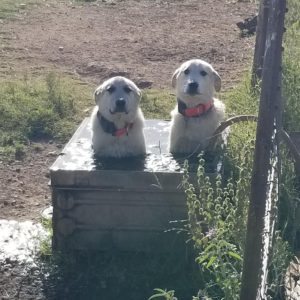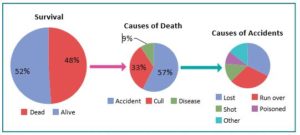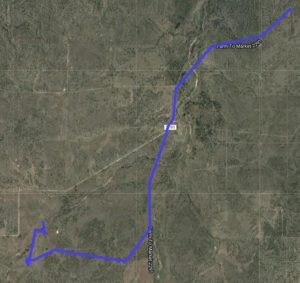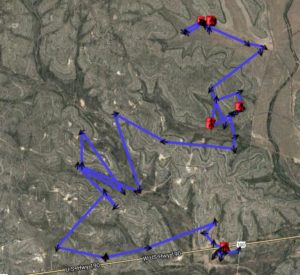 With lots of 100-degree days ahead of us, it’s important to make sure that your LGDs have access to plenty of cool clean water and trees to lay under for shade. Long haired dogs should be brushed out and/or have their hair trimmed on their chests, bellies, lower sides, and inner legs. Make sure to leave at least ½ inch of hair so that they don’t get sunburned. It is not recommended to clip any other areas of your LGD as clipping can interfere with their coat’s natural insulation abilities.
With lots of 100-degree days ahead of us, it’s important to make sure that your LGDs have access to plenty of cool clean water and trees to lay under for shade. Long haired dogs should be brushed out and/or have their hair trimmed on their chests, bellies, lower sides, and inner legs. Make sure to leave at least ½ inch of hair so that they don’t get sunburned. It is not recommended to clip any other areas of your LGD as clipping can interfere with their coat’s natural insulation abilities.
AgriLife Livestock Guardian Dog Program: Events and Update
Our monthly LGD Q&A sessions on Facebook have been going well with producers posting questions and logging on live to view the answers. The live sessions are usually on the first Thursday of the month at 3 p.m. on our Facebook page. If you missed any of the sessions, you can view them on our YouTube Channel.
We’ve made some updates to our website. If you haven’t checked it out in a while, now’s your chance! We have added a page with our crew of LGDs, another page with research literature, new factsheets, and an easy way to find past issues of The Guardian Way.
Roaming vs Patrolling Behavior

A six-year survival of LGDs and causes of losses. Most accidents would not have occurred if the LGD had not left the ranchers property (Lorenz et al. 1986).
Producers often contact us looking for dog breeders or looking for ways to stop juvenile issues in their pups. How to stop LGDs leaving their property is the next most common issue we speak with producers about. It is one of the main problems with LGDs and could be caused by improper bonding techniques when the dogs are puppies. We started the bonding project back in 2019 to help determine if there was a way to curb roaming behavior in adult LGDs. Based on a study conducted in 1986, almost half of the LGDs on ranches were deceased by six years. As seen in the chart above, the main cause of death was from accidents.
Most of the accidents in this study were caused by dogs roaming off ranch boundaries. However, are the dogs really roaming or just patrolling an area larger than we would like? Producers often lump everything a dog is doing away from their charges as roaming. However, producers may be confused about why their dogs are leaving their charges.
Are roaming and patrolling different behaviors? We would say yes! Roaming is more of a random movement of the dog across an area with no real reason other than they are exploring the area. Roaming dogs can travel many miles away from their charges and fail to return in a timely manner, if at all. Patrolling dogs usually have a specific pattern to their behavior. For instance, we have a LGD (Thor) at the Center that most nights between 9-9:15 p.m. leaves his pasture and patrols the neighboring pastures for threats. Once he is done, Thor returns to his charges until the next night. Dogs that are patrolling or chasing a threat often have similar movement patterns. You can determine your dogs’ movements by using a GPS tracker.
We often recommend GPS trackers to producers new to LGDs to use on their dogs so that they can learn their dog’s movement patterns. We believe that dogs are often just patrolling and defending their territory and not really roaming. We have noticed through our use of GPS trackers, that dogs that roam tend to travel in longer straight lines with some direction changes every so often. Dogs that are patrolling or chasing something tend to have more circular loops or lines that zig zag across an area.

Figure 1: LGD Doc showing a classic example of roaming mainly in straight lines. He was found approximately 4 miles from the ranch location. (Texas A&M AgriLife photo courtesy Digital Matters 2022)
As seen in Figure 1, LGD Doc traveled in a fairly straight line on this date. Doc and his sister Thelma have been roaming since they had been released from the bonding pens in 2021. Doc’s travels on this date are similar to his and Thelma’s movements every time the dogs have roamed off the ranch. On this date, Doc was alone and roamed almost four miles from his home ranch.
Earlier in January 2022, both Doc and Thelma traveled south of the ranch in Menard just over four miles away. The pattern that day was very similar to this event. Other dogs that have roamed in the project tend to show similar straight patterns when they are roaming.
A producer could assume that the left picture in Figure 2 showing LGD Laverne, could be a roaming pattern as she traveled across two 1500-acre pastures that day. However, examination of her movements over time show that she usually patrols close to her livestock in a general zig zag pattern. This producer’s ranch has a very high predator load in this area. He had seen a large amount of evidence of predators in the lower pasture. Knowing Laverne’s working pattern and this information it was easy to determine that she was probably chasing a predator across the ranch. The producer found a fresh crawl and hair on the fence by the highway location where Laverne stopped the chase at the bottom of the picture.

Figure 2: Photo on the left shows LGD Laverne in a zig zag pattern. Photo on the right shows LGD Louise in a circular patrol pattern. (Texas A&M AgriLife photo courtesy Digital Matters 2022)
 The picture in Figure 2 on the right, shows the movement pattern of LGD Louise. Louise generally worked in a circular pattern across the pastures she guarded. While she would return to her stocks’ location to check on them, Louise generally patrolled the perimeter of her pastures. GPS trackers can be a great help to producers in determining the movement patterns of their LGDs and areas of possible predator threats.
The picture in Figure 2 on the right, shows the movement pattern of LGD Louise. Louise generally worked in a circular pattern across the pastures she guarded. While she would return to her stocks’ location to check on them, Louise generally patrolled the perimeter of her pastures. GPS trackers can be a great help to producers in determining the movement patterns of their LGDs and areas of possible predator threats.
LGDs & The Bonding Project Update
Round Four Pups
The pups are all doing well and will be spayed/neutered the first week of August. Once our feeding trial is completed in early August the pups will all be taken to the five cooperating producers ranches and released with the dogs they are bonding in this project. All the dogs will be tracked until they are 18 months of age.
Adult Dogs
Thelma finished her treatment of antibiotics for Ehrlichiosis and was returned to the pasture set up with the invisible fence in mid-June with Doc. Neither dog had left the two pastures with the system since they were placed in them in April. The two dogs will be taken back to the ranch in Menard at the end of July and tracked for roaming behavior. Our hope is that the system provides some long-term results and keeps the dogs from roaming as often as they were.
In closing
If you enjoyed this monthly LGD blog, please don’t forget to subscribe to it with this link The Guardian Way | Texas A&M AgriLife Research and Extension Center at San Angelo.
To provide feedback on this article or request topics for future articles, please contact me at bill.costanzo@ag.tamu.edu or 325-657-7311.
The Texas A&M AgriLife Livestock Guardian Dog Program is a cooperative effort by Texas A&M AgriLife Research and the Texas Sheep and Goat Predator Management Board. Make sure to follow us on our social media sites and share them with your friends and family!
Facebook: https://www.facebook.com/TAMUlivestockguarddog/
Instagram: @tamulivestockguarddog
YouTube: https://www.youtube.com/channel/UCF7YbP6bNDV7___6H8mifBA
Don’t forget to check out the Texas LGD Association on online! Follow the organization at https://www.facebook.com/TexasLGDAssociation or check out their website!





